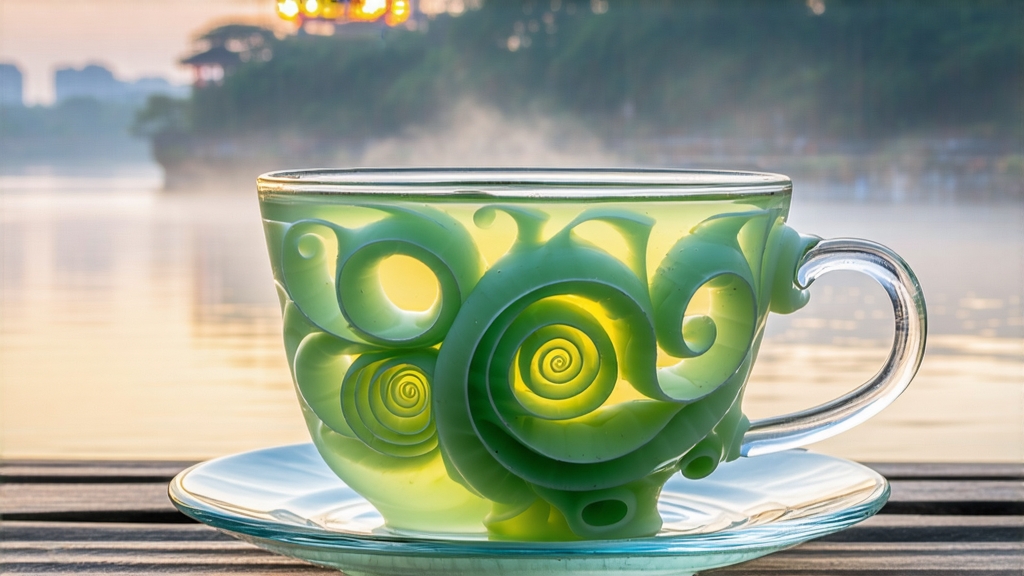
Biluochun, whose name translates literally to “Green Snail Spring,” is one of China’s ten most celebrated teas, yet it remains a quiet jewel outside the circles of devoted tea lovers. Grown in the mist-laden microclimate where the eastern edge of Jiangsu Province meets Taihu Lake, this emerald-green tea has been seducing emperors, poets, and farmers since the late Tang dynasty. Its tiny, spiral-shaped leaves look like miniature snail shells, hence the charming moniker, but the romance of Biluochun goes far beyond appearance: it is the taste of early spring condensed into a single sip, a fragrance that carries the aroma of apricot blossoms, and a craft that balances the precision of a watchmaker with the intuition of an artist.
Historical whispers place Biluochun’s birth in the Dongting mountain range that rises from Taihu’s shores. During the reign of Emperor Kangxi in the Qing dynasty, the tea was presented at court under its original folk name “Xia Sha Ren Xiang”—literally “Scary Fragrance”—because its perfume was so arresting that servant girls feared it was sorcery. The emperor, amused and delighted, renamed it Biluochun for its shape and harvest season. From that moment the tea was locked into imperial tribute lists, and mountain villages like Dongting Dongshan and Xishan became hives of activity each March, when the lake’s morning fog retreated just enough for pickers to scramble up terraced groves of tea bushes interplanted with fruit trees.
Strictly speaking, Biluochun is not a single cultivar but a stylistic fingerprint applied to several local clones of Camellia sinensis var. sinensis. The most prized is the “Xiao Ye” or small-leaf strain, whose tender buds yield higher amino acids and a sweeter, less astringent liquor. Farmers also keep scattered plots of the middle-leaf “Dongting” type, which carries more floral volatiles thanks to the peach, plum, and apricot trees that shade the bushes. This fruit-tree association is no accident; the pollen and petals that drift onto tea leaves are credited with Biluochun’s unmistakable orchard perfume. In recent decades researchers at Nanjing Agricultural University have mapped the terroir: the lake regulates temperature, creating a diurnal swing of 8–10 °C that slows growth and concentrates flavor, while the granite-based, slightly acidic soil supplies minerals that translate into a silky texture.
Plucking follows lunar, not market, calendars. Only the bud and the immediately adjacent half-expanded leaf are taken, and only before Qingming festival, when the spring energy of the plant is still ascending. Experienced pickers work with thumb and index finger in a single twisting motion that snaps the stem without squeezing sap from the cut, a detail that prevents premature oxidation. A full day’s harvest by one person—about 20,000 shoots—yields barely 500 g of finished tea, which explains why authentic early-spring Biluochun often costs more per gram than silver.
The crafting choreography begins the same night. First comes “killing green,” a poetic Chinese term for enzymatic deactivation. Leaves are tumbled for precisely 3–4 minutes on a cast-iron pan heated to 180 °C. The master’s bare hand is the thermometer: too hot and the leaf blisters, too cool and grassy notes persist. Next is the first rolling, performed while the leaf is still too hot to touch with bare skin; bamboo tweezers are used to curl the leaf into tight spirals around the bud. This step must last 12–15 minutes, during which moisture drops from 72 % to roughly 50 %. A brief 10-minute rest follows, allowing internal leaf pressure to equalize so that later firings do not burst the cells.
The most cinematic phase is the “three firings, three coolings” cycle. Temperature is lowered in steps—130 °C, then 100 °C, finally 60 °C—while the tea master continuously tosses, presses, and rubs the leaves against the pan surface. Each rub is a calculated caress: too light and the spiral loosens, too heavy and the leaf fractures. Between firings the tea is laid on woven bamboo trays to cool and reabsorb ambient humidity, a rest that prevents the surface from drying faster than the stem. By dawn the leaves have shrunk to one-sixth their original volume, sporting a downy white bloom that resembles frost on moss. Master Chen Lihua, a fifth-generation crafter, describes